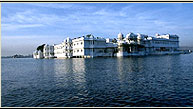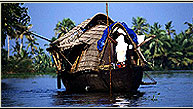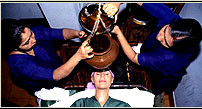Buddhist Sites
-| Bharhut | -
Location: District- Satna (Madhya Pradesh) - Lat 80º 52'E, Long
24º 27'N
The site is located about 15 kms. south of Satna railway station. The ground
plan of the stupa with the great railing and the eastern gate is now housed
in Indian Museum, Calcutta and Allahabad museum, Allahabad (U.P.). Situated
at foot of the hill called Lal – Pahar, the site has only a shallow circular
depression around a slightly raised circular ground. That is all that can be
seen of the main stupa. The stupa was made of brick and finished with a coat
of plaster on the exterior. The names of the donors hailed from distant places
like Vidisa, Basenagar, Kurhakata (Karhad) District Satara (Maharashtra), Nasik,
Kaushambi (Kosam) near Allahabad and as far as Patliputra (modern Patna in Bihar).The
railing was luxuriantly carved with profusion of bas – relief through a
flood of light on the Buddhist religion, art, tradition, beliefs and practices
etc. It was at this site that the narrative elements were used for the first
time in the form of the Jatak's( tales of Buddha's previous birth) and the life
scenes of Buddha. These narratives scenes (introduced in the Shunga period)
have two fold significance - 1) to beautify the cherished objects of sanctity
and 2) the visual representation to imprint permanently on the minds of masses
as these have far more impact than the text that describes them. In the life
scene carved on the railing, Lord Buddha was never represented in human form.
Whenever a scene demanded for portrayal, his presence was depicted by some symbols
– a seat, tri-rathas or footprints. A throne under Bodhi tree and a stupa
symbolized respectively of enlightenment, sermon or demise.
The art at Bharhut was the vigorous expression of a mass movement compared to
the imperial court art of the Maurya's with its classical qualities. This indigenous
folk art appears archaic. The method of depicting narrative in small space is
often extremely abridged. The craftsman of the Shunga period had a fine natural
bent for decorative beauty and could weave certain motifs like creepers and
flowers into things of surprising excellence. The site was deserted after the
11th century AD. A medieval temple, with a colossal image enshrined within,
was also located earlier on the site of Bharhut.
Bharhut
- Buddhist, Archaeology in India
Reservation Form
 Log On To: Log On To: |



